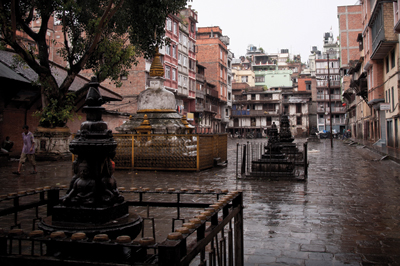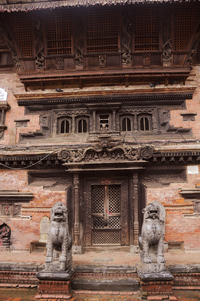Kathmandu’s Basantapur Durbar Square is home to more than royal palaces and temples.
Perhaps the two most important features, besides its people, of Kathmandu that give it lasting charm are the hills and mountains that surround it and the streets that run through it. The streets and alleys of the city, especially the ones that are concealed or forgotten, offer solace for those who pine for the valley’s glorious past. The richer structures of historical and cultural importance are off the frequented routes, exiled from view by taller buildings.
 Some of Kathmandu’s most brilliant works of architecture are not on the tourist guide’s itinerary. This is a fact that troubles Durgesh Man Singh, a former ambassador to the European Union. While he was in Brussels, he noticed that the most popular tourist attraction was the city’s old square. Singh had grown up near and around bahals - traditional Newari courtyards. It saddened him to see these courtyards slipping into oblivion. What used to be the centre of social and cultural life had been reduced in many cases to parking lots. “Bahals have never received the kind of attention they deserve,” Singh laments.
Some of Kathmandu’s most brilliant works of architecture are not on the tourist guide’s itinerary. This is a fact that troubles Durgesh Man Singh, a former ambassador to the European Union. While he was in Brussels, he noticed that the most popular tourist attraction was the city’s old square. Singh had grown up near and around bahals - traditional Newari courtyards. It saddened him to see these courtyards slipping into oblivion. What used to be the centre of social and cultural life had been reduced in many cases to parking lots. “Bahals have never received the kind of attention they deserve,” Singh laments.
Bahals were never grand sites. They didn’t have the majesty of places where kings lived or the intrigue of where royals were murdered. However, they have been much more stable than palaces and have preserved their heritage more successfully. “Experiencing Kathmandu’s heritage is every tourist’s aim. Our heritage is not just about kings, maharajas and prime ministers. It’s about the people,” says Singh. It is the common people’s lifestyle, and not just that of the rulers’, that Singh believes enriches and adds to the valley’s history.
Tourist guides in Kathmandu seem to have a penchant for size: the highlights of their tours are inevitably the biggest temples, squares and palaces. The Basantapur Durbar Square is one such place, where guides can be seen regaling enraptured tourists with stories that took place inside the palace walls. Singh feels sorry for these tourists. “Tourists have breakfast in their star hotels, and are driven to Basantapur. They spend some time in the square and go back thinking they have seen Kathmandu,” he says. He feels that a society cannot be understood or appreciated simply by visiting a palace or a museum. “There are so many artists, goldsmiths, sculptors, musicians in the periphery of Basantapur. Their lifestyle is just as interesting as that of any king.”
 One of the sights that amazed Singh during his travels in Europe was the hoards of people that came to see the house in which the famous artist Ruben had lived. “Imagine how many houses of artists there must be in Kathmandu,” he told me. There surely are many houses of people versed in other esoteric arts and professions as well. More than just being houses, they are enclaves where ancient lifestyles and traditions find refuge. Singh believes that tourists seek such things. “Tourists are interested in the occupations that have been practiced by generations after generation, the family structures of such people, the style of their houses and other aspects of their lives that cannot be found in museums.”
One of the sights that amazed Singh during his travels in Europe was the hoards of people that came to see the house in which the famous artist Ruben had lived. “Imagine how many houses of artists there must be in Kathmandu,” he told me. There surely are many houses of people versed in other esoteric arts and professions as well. More than just being houses, they are enclaves where ancient lifestyles and traditions find refuge. Singh believes that tourists seek such things. “Tourists are interested in the occupations that have been practiced by generations after generation, the family structures of such people, the style of their houses and other aspects of their lives that cannot be found in museums.”
Bahals are the ideal place to experience the local lifestyles. Within walking distance from Singh’s house are two of Nepal’s most famous bahals, Itum Bahal and Yetkha Bahal, the former the longest and the latter the biggest bahal in Nepal. He passionately feels the need to revive these ancient quadrangular courtyards, a visit to which reveals that the affection Singh has for bahals is not because of their proximity to his ancestral house, but because they bring him, and anyone who visits them, closer to a lifestyle, a time, a culture that is gradually getting remoter.
I t is a place where a tree smeared in vermilion and entwined with sacred thread is allowed to grow higher than the surrounding houses. Women with traditional tattoos dry their hair in the sun. Daughters scrub the backs of their bathing mothers. It is so quiet, so detached, so immune to the cares of the boisterous world just a few paces away that you feel that its residents have preserved not just their lifestyle, but time itself.
t is a place where a tree smeared in vermilion and entwined with sacred thread is allowed to grow higher than the surrounding houses. Women with traditional tattoos dry their hair in the sun. Daughters scrub the backs of their bathing mothers. It is so quiet, so detached, so immune to the cares of the boisterous world just a few paces away that you feel that its residents have preserved not just their lifestyle, but time itself.
The open space of a bahal is like an open-air theatre, with daily performances of culture and tradition. It is to such a performance that Singh wishes to see tourists coming. “My concept is to have tourists walk into the culture and heritage of Kathmandu.” An advocate of promotion of traditional lifestyle and customs, he is also aware of the challenges of reviving bahals. “There should be shops selling objects made by the local craftsmen; we also need restaurants. The locals don’t benefit if the tourists visit their neighborhood, but go to a five-star hotel for a cup of tea. The money generated from tourists must trickle down to the locals.” Singh envisions the revival of bahals as a place where people carry on the professions of their ancestors and benefit economically by preserving tradition.
The importance of bahals is not limited to being places where the past lingers. Itum Bahal was where Ganesh Man Singh, the doyen of the movement for democracy in Nepal, used to deliver his famous speeches. Though a revolution may have originated in a bahal, its appeal comes from its mythology and folklore. Itum Bahal was apparently built by Keshchandra, a failed businessperson, who received a huge amount of gold from a deity who took pity on him. Unable to carry the gold himself, he sought the help of a demon, Gurumapa, under the condition that he would provide the demon with a human to feed on everyday. Keshchandra built Itum Bahal, but soon Gurumapa, who had been allowed to carry away any mischievous child, began abducting children at whim. Finally, Keshchandra convinced Gurumapa to leave his neighborhood for Tundikhel, promising demon a daily feast of buffalo meat and rice. Even today, locals slaughter a buffalo once a year, from which delicacies are prepared and carried to Tundikhel as an offering to Gurumapa.
 An old, decaying wooden house in the vicinity of Itum Bahal is the source of a more romantic lore. The house is believed to be where Rajamati, a bewitchingly beautiful girl lived. The story of Rajamati, who supposedly had all the young men of the city in a spell, has been immortalized in a song. Tej Ratna Tamrakar, an expert in monument preservation, says that the song was so popular that when Jung Bahadur Rana was asked by the British during his visit to England about his country’s national song, his aide had promptly proceeded to sing the song about Rajamati.
An old, decaying wooden house in the vicinity of Itum Bahal is the source of a more romantic lore. The house is believed to be where Rajamati, a bewitchingly beautiful girl lived. The story of Rajamati, who supposedly had all the young men of the city in a spell, has been immortalized in a song. Tej Ratna Tamrakar, an expert in monument preservation, says that the song was so popular that when Jung Bahadur Rana was asked by the British during his visit to England about his country’s national song, his aide had promptly proceeded to sing the song about Rajamati.
Bahals are glimpses into history. Bahals, and all the other structures in their vicinity, tease and entice you with their combination of age, history and mystery. Standing in them, one feels a surging fascination and a feeling that something wonderful lingered there, and that it would reveal itself if one were to wait. It was a feeling similar to what an admirer of the enchanting Rajamati must have felt standing under her window, hoping to catch a glimpse of her lovely face.










